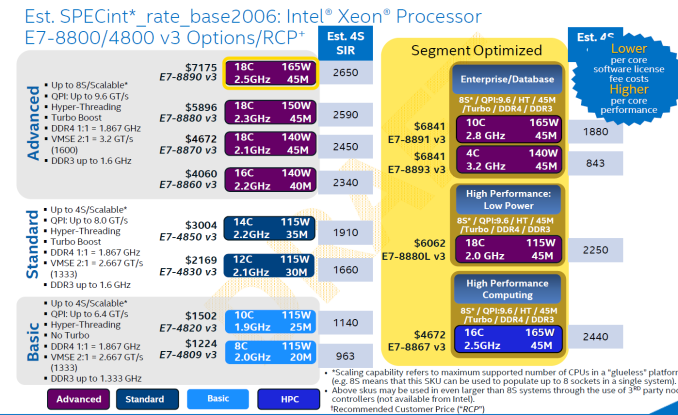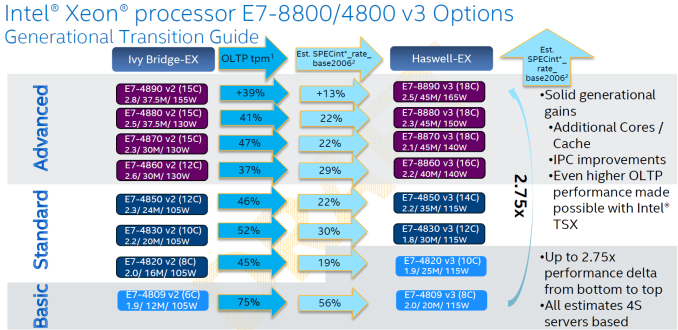The Intel Xeon E7-8800 v3 Review: The POWER8 Killer?
by Johan De Gelas on May 8, 2015 8:00 AM EST- Posted in
- CPUs
- IT Computing
- Intel
- Xeon
- Haswell
- Enterprise
- server
- Enterprise CPUs
- POWER
- POWER8
Xeon E7 v3 SKUs and prices
Intel SKU list has always been complex and very long. For reference, this is what the Xeon E7 v2 line-up looked like when it launched in 2014:
There is a scalable 2S line that is not scalable beyond 2 sockets, a frequency optimized 8857 which is probably faster in many applications than the 8893 and so on.
Luckily, with the introduction of the Xeon E7 v3, Intel simplified the SKU list.
First of all, the hardly scalable 2 socket version is gone. And at the low-end, you now get a 8-core processor at 2 GHz instead of a 6-core at 1.9 GHz. Well done, Intel.
The high-end models are all capable of running in 8 socket configurations. But the enterprise people looking for a high-end quad socket system have to pay a bit more: about 8 to 10%. Most enterprise people will not care, but getting 20% more cores (slightly improved) at 8-10% lower clocks while paying about 8% more is not exactly a vast improvement. Of course these are paper specs, but Intel used to be (a lot) more generous.
Intel's own slides confirm this. The gains in SPECint2006_rate are pretty small to justify the price increase. Intel claims higher OLTP (TPC-C) increases, but the mentioned gains are rather optimistic. For example, the HammerDB benchmark runs 29% faster on the E7-8890 v3 than on the E7-4890v2. This benchmark is much more transparant, straight forward and easier to reproduce than TPC-C, so we feel it is probably closer to the real world. Secondly, in both cases (HammerDB and TPC-C), the E7-8890v3 had twice as much memory (1 TB vs 512 GB) memory as its predecessor.
Lastly, these are benchmarks after all. In the real world systems are not running at full speed, so the gains are much smaller. So it seems that in most applications besides the TSX/AVX2 enabled ones, the gains will be rather small.













146 Comments
View All Comments
PowerTrumps - Saturday, May 9, 2015 - link
Oracle has been unable to develop a power core let alone a processor. What they have done is created servers with many cores and many threads albeit weak cores/threads. The S3 core was an improvement and no reason to think the S4 won't be decent either. However, the M7 will come (again, true to form) with 32 cores per socket. It will be like 8 mini clusters of 4 cores because they are unable to develop a single SMP chip with shared resources across all of the cores. As such, these mini clusters will have their own resources which will lead to latency and inefficiencies. Oracle is a software business and their goal is to run software on either the most cores possible or the most inefficient. They have both of these bases covered with their Intel and SPARC business.Also, performance per Watt is important for Intel because what you see is what you get. With Power though, when you have strong single thread performance, strong multi-thread performance and tremendous consolidation efficiency due to Power Hypervisor efficiency means ~200W doesn't matter when you can consolidate 2, 4 maybe 10 Intel chips at 135W each into a single Power chip because of this hypervisor efficiency.
tynopik - Friday, May 8, 2015 - link
pg4 - datam iningder - Friday, May 8, 2015 - link
Woo...we're bout to have another GHz War here!usernametaken76 - Friday, May 8, 2015 - link
I'm sure you mean figuratively. We've been stuck between 4-5 GHz on POWER architecture for closing in on a decade.zamroni - Friday, May 8, 2015 - link
My conclusion is Samsung should buy AMD to reduce Intel dominance.alpha754293 - Friday, May 8, 2015 - link
It would have been interesting to see the LS-DYNA benchmark results again (so that you can compare it against some of the tests that you've ran previously). But very interesting...JohanAnandtech - Friday, May 8, 2015 - link
Give me some help and we'll do that again on an update version :-)alpha754293 - Tuesday, May 12, 2015 - link
Not a problem. You have my email address right? And if not, I'll just send you another email and we can get that going again. :) Thanks.andychow - Friday, May 8, 2015 - link
If Samsung bought AMD, they would lose the licence for both x86 and x86_64 production. It would in fact ensure Intel's dominance of the market.Kevin G - Friday, May 8, 2015 - link
The x86 license can be transferred as long as Intel signs off on the deal (and it is in their best interest to do so). What will probably happen is that if any company buys AMD, the new owner will enter a cross licensing agreement with Intel.